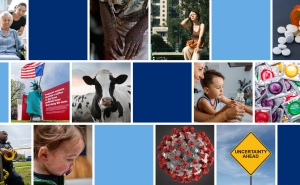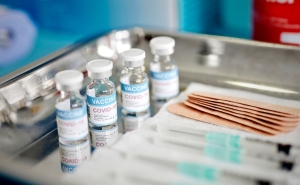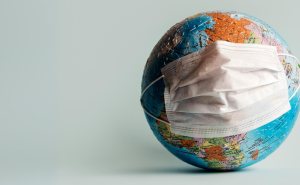How COVID-19 Created a ‘Watershed’ Moment for Wastewater Surveillance
Wastewater surveillance can alert researchers to potential COVID outbreaks, often detecting cases before symptoms arise. This tool may have the potential to track other disease outbreaks as well.

Wastewater surveillance is exactly what it sounds like: Concentrated wastewater samples are collected and screened for different bacteria or viruses that may be present in a given community.
Researchers like Natalie Exum, PhD ’16, an assistant scientist in Environmental Health and Engineering, have used this tool during the pandemic to spot potential COVID outbreaks, often before community cases are reported, as genetic material from the virus can be detected in fecal matter.
In this Q&A, adapted from the April 27 episode of Public Health On Call, Exum speaks with host Stephanie Desmon about how wastewater surveillance works and its potential for monitoring outbreaks from other viruses, including influenza and respiratory syncytial virus.
WHAT IS WASTEWATER SURVEILLANCE AND WHY IS IT USEFUL?
It’s basically flushing your toilet and getting a sample from that waste stream anywhere from when that flush starts all the way down to when it gets to the wastewater treatment plant. We look at the viral and bacterial genomes of whatever it is you’re flushing down that toilet.
We can use this to detect bacteria and viruses, as well as other things like opioids, or other markers [in] human excretion. This is useful, especially for the pandemic, because we’re able to track infections at a community level in a population-based way.
HOW IS WASTEWATER SURVEILLANCE ACTUALLY DONE?
It’s as simple as you would think: You get a bottle and you can get a concentrated sample from a wastewater treatment plant, which is then brought to an environmental lab. From that, you’ll be able to get a readout of the virus and its concentration—so when we have a big spike in cases, that will correspond to the amount of virus in the wastewater.
Public Health On Call
This article was adapted from the April 27 episode of Public Health On Call Podcast.
WHY IS THIS USEFUL TO HEALTH PROFESSIONALS?
Wastewater can be used as an anonymous pooled sample to provide a look at what’s happening in the community and inform strategies around mitigation measures.
With at-home antigen tests, people are testing positive but aren’t reporting it to the health department. Health professionals previously used these indicators to understand what’s happening in the community.
CAN YOU IDENTIFY DIFFERENT VARIANTS OF SARS-CoV-2 USING THIS METHOD?
Absolutely. Wastewater surveillance really showed its usefulness during the omicron wave. Wastewater was able to tell us early on where this variant was spreading. For example, research showed that in New York, omicron was detected in the wastewater way before we got the first [documented] omicron case on the East Coast.
HOW DOES THIS KIND OF SURVEILLANCE COMPARE TO INDIVIDUAL CLINICAL TESTING FOR COVID-19?
You can get a look at your whole community in one day. With a quick turnaround, it can be extremely useful as a leading indicator of what’s happening in our population.
ARE THERE ANY DOWNSIDES TO USING WASTEWATER SURVEILLANCE?
Yes. This should not be viewed as a replacement for testing. It needs to be seen as one tool that health departments can use to get a clearer picture of what’s happening in their population.
HOW HAS THE PANDEMIC REVOLUTIONIZED THE FIELD OF WASTEWATER EPIDEMIOLOGY?
During the pandemic, the methods of extracting the virus from a wastewater sample had to be innovated and developed quite quickly. Over time, when we began to correlate concentrations of virus in the wastewater with community case levels, we began to realize what a useful tool this could be.
HOW HAS WASTEWATER SURVEILLANCE BEEN USED IN THE PAST?
Prior to the pandemic, it was used to track polio. For instance, polio may not be circulating in the population, but if you look in the wastewater, you may find it there. Some communities also used it to track opioid use.
Before COVID, people wanted to use it for more pathogens like norovirus or salmonella and/or foodborne outbreaks, but setting up the infrastructure never seemed worth the investment. Now we can leverage the investment made [for COVID-19] for other diseases..
Overall, the pandemic has been a real revolution for wastewater-based epidemiology.
ARE MORE PLACES NOW UTILIZING WASTEWATER SURVEILLANCE?
Yes. The CDC has incorporated all wastewater data that they can get from wastewater treatment plants across the country into the national wastewater surveillance system. These sites are listed on a correlated map, which tracks percent change in wastewater in all of the reporting sites.
If you’re concerned about traveling to a certain state or county, it’s a helpful way to determine risk.
WHAT DOES THE FUTURE LOOK LIKE FOR THIS FIELD OF RESEARCH?
The pandemic has provided a watershed moment, so to speak, for wastewater surveillance. I think we will continue to see COVID wastewater surveillance hopefully through when the virus becomes endemic, but also for other viruses like influenza. We’ve already seen outbreaks of influenza virus being detected through wastewater, as well as tracking when RSV starts to spread in a community.
We can also begin to use this for antibiotic resistance genes. The CDC is very interested in using [this kind of surveillance] in acute care and/or hospital settings to understand what antibiotic resistance genes are circulating.
Stephanie Desmon is the co-host of the Public Health On Call podcast. She is the director of public relations and marketing for the Johns Hopkins Center for Communication Programs, the largest center at the Johns Hopkins Bloomberg School of Public Health.





